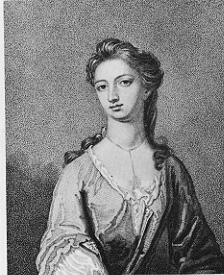
Lecture Title: Beauty in Women and Poetry
"Beauty (unlike ugliness) cannot be explained." Roland Barthes, S/Z

Mrs. Arabella Fermor (note the cross in the portrait)
| The question that begins The Rape of the Lock |
|
Say what strange Motive, Goddess! cou'd
compel |
| The questions and paradoxes of Beauty |
|
Questions
|
|
The paradoxes surrounding beauty's power:
|
| How is Belinda's Beauty rendered? |
| Canto II: ll. 1-18 Not with more Glories, in th' Ethereal Plain, The Sun first rises o'er the purpled Main, Than issuing forth, the Rival of his Beams Launch'd on the Bosom of the Silver Thames. Fair Nymphs, and well-drest Youths around her shone, But ev'ry Eye was fix'd on her alone. On her white Breast a sparkling Cross she wore, Which Jews might kiss, and Infidels adore. Her lively Looks a sprightly Mind disclose, Quick as her Eyes, and as unfix'd as those: Favours to none, to all she Smiles extends, Oft she rejects, but never once offends. Bright as the Sun, her Eyes the Gazers strike, And, like the Sun, they shine on all alike. Yet graceful Ease, and Sweetness void of Pride, Might hide her Faults, if Belles had Faults to hide: If to her share some Female Errors fall, Look on her Face, and you'll forget 'em all. |
| Features of the verse form used in The Rape of the Lock: the heroic couplet |
|
Example: |
|
|
What effect is produced by the heroic couplet:
|
| Exalting Belinda and Critiquing Her : Canto II: 1-18 |
| Not with more Glories, in th' Ethereal Plain*, (*sky) The Sun first rises o'er the purpled Main*, (*ocean) Than issuing forth, the Rival of his Beams Launch'd on the Bosom of the Silver Thames*. (*the London river) |
|
| Fair Nymphs*, and well-drest Youths* around her shone,
(*girls and guys) But ev'ry Eye was fix'd on her alone. On her white Breast a sparkling Cross she wore, Which Jews might kiss, and Infidels adore. |
|
| Her lively Looks a sprightly* Mind disclose,
(*spirited) Quick as her Eyes, and as unfix'd as those: Favours to none, to all she Smiles extends, Oft she rejects, but never once offends. Bright as the Sun, her Eyes the Gazers strike, And, like the Sun, they shine on all alike. |
|
| Yet graceful Ease, and Sweetness void of Pride, Might hide her Faults, if Belles had Faults to hide: If to her share some Female Errors fall, Look on her Face, and you'll forget 'em all. |
|
|
The media and beauty:
|
| The response to beauty |
| What is the significant of Belinda's locks? How are they connected to her beauty? |
| This Nymph, to the Destruction of Mankind, Nourish'd two Locks which graceful hung behind In equal Curls, and well conspir'd to deck With shining Ringlets the smooth Iv'ry Neck. Love in these Labyrinths his Slaves detains, And mighty Hearts are held in slender Chains. With hairy sprindges* we the Birds betray, (noose traps) Slight lines* of Hair surprise the Finny Prey, (fishing lines) Fair Tresses Man's Imperial Race insnare, And Beauty draws us with a single Hair. II: 19-28 |
| What do you suppose motivates the Baron's plot? Why does it take this form? |
|
Th' Advent'rous Baron the bright Locks admir'd, |
Backstage: beauty as an effect of art
the role of the Sylphs who guard her; (I:19-114)
the artistry of the dressing table (I:121-148)

Beardsly illustration:
Now awful Beauty puts on all its Arms;
The Fair each moment rises in her Charms,
Repairs her Smiles, awakens ev'ry Grace,
And calls forth all the Wonders of her Face;
Sees by Degrees a purer Blush arise,
And keener Lightnings quicken in her Eyes.
| For next time: how does Pope correct Belinda and her beauty by inscribing it into a complex social world? |